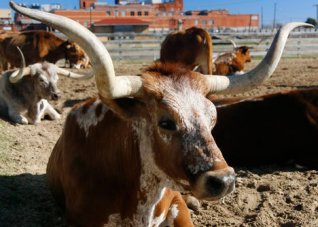 DALLAS, A vast swathe of Texas remains in the grip of a scorching drought, which has cost billions of dollars and is cleaving America’s largest beef cattle herd.
DALLAS, A vast swathe of Texas remains in the grip of a scorching drought, which has cost billions of dollars and is cleaving America’s largest beef cattle herd.
One county has seen its entire cotton harvest wiped out and losses for cattle, crops and the state’s fast growing game farming industry are seen mounting with no relief in sight. Texas is second only to
California in U.S. farm production and the sector’s sales for the state topped $21 billion in 2007.
The drought-stricken area straddles the central Texas hill country, near the capitol Austin, and stretches south through San Antonio to the Rio Grande Valley on the U.S./Mexico border, which is a key citrus and cattle region.
According to the U.S. Drought Monitor here, much of this area is experiencing exceptional drought conditions. That is the worst possible ranking and it is the only part of the country that currently falls into this category.
Other areas of south/central Texas are suffering extreme conditions. In most of the affected counties the rains began to taper off sharply around September of 2007. In at least nine counties, the drought is the worst on record.
According to the Climate Prediction Center, the outlook for the next three months over the region in question shows equal chances for above, normal or below average rainfall.
“But there is a good chance of higher than normal temperatures and so the drought will not likely abate soon,” said John Nielsen-Gammon, the Texas State climatologist.
Texas AgriLife Extension Service, which is linked to Texas A&M University, said in July that it estimated that the losses to Texas agriculture since November of 2008 amount to $3.6 billion and counting.
Almost a $1 billion of those losses were in livestock with the remainder in crops.
“If it doesn’t rain soon, we expect this year to eclipse 2006, when we estimate drought losses were $4.1 billion,” David Anderson, a professor at Texas AgriLife, told Reuters.
SHRINKING CATTLE HERD
Anderson said that in January 2009, United States Department of Agriculture surveys showed there were two million beef cows in the drought-stricken area, or 40 percent of the Texas herd and six percent of the U.S. total.
That number is expected to drop sharply this year as farmers are forced to sell or cull cattle in the face of soaring costs for supplemental feed needed just to keep meat on their ribs.
“In the most severe areas, I would say that anywhere from 12 to 18 percent of the cattle have been sold,” said Dave Scott, president of the Texas and Southwestern Cattle Raisers Association.
He said it just was not economical to maintain normal herd numbers when there was virtually no grass for grazing and the price of supplements like hay were going through the roof.
“All the hay is being shipped in from out of the state and the northern part of the state. It’s not really economical. It’s about $80 for a 1,200 pound (545 kgs) roll of hay. In normal times, it is somewhere around $30 to $35,” he said.
The drought is also impacting on the state’s exotic game industry, which one 2007 study Texas AgriLife estimated to be worth $1.3 billion. The study also found it to be the fastest growing sector of the state’s farming industry.
Many of the state’s exotic game ranches cater to the big game hunting industry and along with leases for native white-tailed deer is a huge supplement to the income of livestock farmers. Like cattle, such herds are also reeling from drought and ranchers need to provide them with additional feed.
“If things don’t reverse, I don’t know how exotic ranchers can keep holding out,” said Charly Seale, Executive Director of the Exotic Wildlife Association.
Less exotic sectors have also been badly hit.
“For the first time in over a century … drought has claimed the entire cotton production of Kleberg County,” Texas AgriLife said last week.
In the Lower Rio Grande Valley, it said this week that irrigated crops had managed to weather the drought but dryland crop losses in the area for cotton, corn and grain sorghum could top $25 million this year.
The weather has been uneven across Texas. Other parts of the state have been under either mild drought conditions or have received ample rainfall.
(Editing by Marguerita Choy)


